|
|
Additional
information on
|
|
Nikon (Nippon
Kogaku K.K.) RF W-Nikkor.C 1:3.5 f=2.8cm (28mm f/3.5)
wideangle lens for Nikon S-Mount Rangefinder cameras
|
HTML File Size: 72K Loading ...
| The Nikkor 28mm focal length
with the bayonet S-mount was introduced in September, 1952. It had brought a new
dimension for rangefinding photography because prior to its release, the only wideangle
for the Nikon S-series bodies was limiting to 35mm focal length. In fact, even after
the reflex Nikon was introduced and stretched until the late '70, fixed focal length
35mm lenses were still being widely regarded as a "standard wideangle"
for 35mm photography. So, picture angle wider than 35mm was considered "really
wide" durig those days. However, the 2.8cm RF Nikkor was very well received
in the market after its debut, primarily because of its practical element in delivering
wider picture coverage as well as a more forgiving depth of field control as a native
wideangle. Although the maximum aperture of f/3.5 was considered as quite slow; but
gradually, news/reportage photographers, photojournalists and even the general public
were slowing accepting the 28mm focal length Nikkor as a very practical lens for
a wide varieties of photography. Further, during those days, the photographic world
was still black & white dominated and one can still use dark room technique to
compensate for its slight lack of lens speed. Probably, as Robert Rotoloni has pointed out in
one of his publication, the popularity of this Nikon RF wideangle was partly due
to it was cheaper priced than a comparing RF Nikkor 5cm f/1.4 standard lens, the claim may has
a more realistic basis along with other reasons mentioned earlier. Another major
reason I think was probably due to competition, Canon had produced a S-mount Serenar
28mm f/3.5
in October, 1951 - it was the fastest 28mm wideangle during that time, making the
likes of Leitz's f/6.3 and Zeiss's f/8.0 pale in comparison in lens speed and usability.
So, in a way, both the Japanese manufacturers were competing with each other to capture
market share predominated by Leica and Contax earlier in the wideangle segment. |
| |
| NOTE:- Leica first introduced
their true wideangle, Leitz Hektor 2.8cm f/6.3 (1935~1955) to counter Contax's
Carl Zeiss Jena 2.8cm f/8.0 Tessar (far left picture). In 1955, Leica replaced
the 2.8cm Hektor with a Leitz Summaron 28mm f/5.6 with improved maximum aperture
from f/6.3. You may notice all the early versions were slow lenses. The more modern
version of the Elmarit 28mm f/2.8 was only being introduced quite late in 1965. I
am not so good at Leica/Contax gears but I think prior to Leica M4P (1981) none of
the Leica bodies had a built in bright-line frame for 28mm focal length. Canon 1951
attempt with the Serenar 28mm f/3.5 was shown below - it was used to be the world's
fastest 28mm wideangle lens at the time of its introduction. Also please note the
Canon 28mm Senerar lens was termed as "ULTRA-WIDEANGLE" (refer to the lens
case at far right picture) which gives a clue on the state of wideangle lens development
during that period. You can check Peter
Kitchingman
site for more info on the Canon RF lens group. |
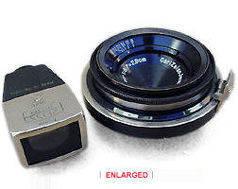 |
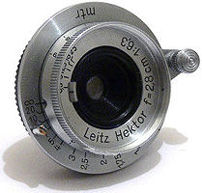 |
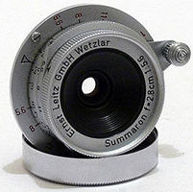 |
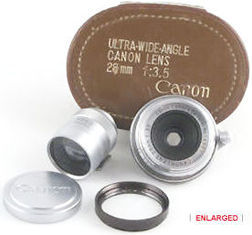 |
| Credit:- The Zeiss
2.8cm f/8.0 above courtesy of Camera$@EBAY® which is my personal favorite
EBAY
STORE.
Both the lovely shots of the Leica's Leitz Hektor 2.8cm f/6.3 and Summaron 2.8cm f/5.6 shown above courtesy
of TheClassicCamera, UK. The picture of
the RF
Canon 2.8cm f/3.5
(far right) with Canon original / leather case dedicated Optical Finder courtesy
of Mr. Brian Edwards who also has also a personal
Portfolio
on his own. All images displayed herein belonged to the respective contributors /
Copyright © 2008. All rights reserved. Please respect the visual property of
the contributing photographer. |

Basic information on
Nippon Kogaku K.K. W-Nikkor.C
1:3.5 f=2.8cm
(28mm f/3.5) M39 Screw-Mount (SM*) wideangle lens
Introduced: August, 1953; Discontinued: No info
There
were actually two versions of the RF Nikkor 2.8cm f/3.5. After Canon's Serenar 2.8cm
f/3.5 Mk I was released (Picture at top right); citing the Serenar successful debut,
Nikon had followed the path with a Leica M39 Screw Mount version in order to capture
market share from the German made labels which lacked a countering measure for a
28mm wideangle lens with practical lens speed. It was not known whether the SM version
was introduced earlier than Nikon S-mount version or not but according to Peter
Braczko's Nikon handbook,
he had suggested the SM version was beginning to appear in Nikkor lens catalogue
back in 1952. As Nikon own S-mount version was also being introduced in Sept. 1952
but I don't think it is important to pick on the exact date of release. But a more
interesting feature is, the SM Nikkor RF version had some slightly different appearance
from the eventual Nikon RF release. However, optically all versions available in
the 2.8cm RF Nikkor were believed to have been sharing the same optical formula which
is 6 elements in 4 groups design*.
* Ref:- NIkon
stated "... the 2.8cm lens was based on the Ortho-NIKKOR 18 cm f/4.5 with 6-element
construction for 18 x 13 cm format aerial camera, which had superb resolving power
and little distortion, converted to a lens for 135 format with further improvement
of aberrations and attained maximum aperture of f/3.5...."- Nikon Japan. I am
not good at larger format lenses than 135mm and it acted as a reference only. |
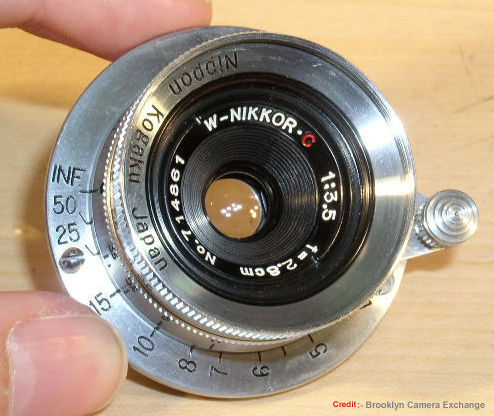 |
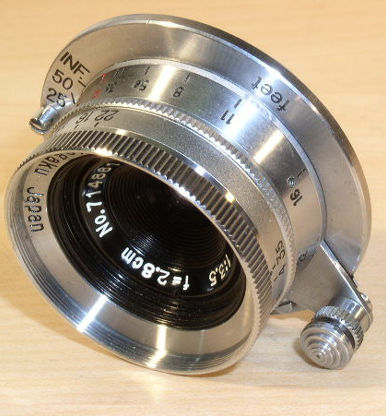 |
| Credit: Image courtesy of
Broklyn Camera
Exchange@EBAY®. The Company also operates an active
Ebay Store. Image copyright
© 2006. All rights reserved. |
| Firstly, the
SM version of the RF W.Nikkor 2.8cm f/3.5 was supplied only in all chrome finish.
A distinctive difference between the SM/S-mount was the distance scales marked on
the SM version was printed on the external ring (the largest rotating ring closest
to the camera body). The version shown above has a higher serial number with 7148XX
but P.Braczko hand book's showcased a photo of SM version which has a smaller starting
S/N from 3447xxx. (whereas since BOTH marked with "W-Nikkor.C", so I would assume all series of this
2.8cm SM lenses were coated). However, it was rather confusing, as comparing data
presented from R.Rotoloni's Hand Book copy, the S/N may have duplicated along with
the S-mount. Anyway, I am not a historian, but there are probably around 10,000 of
these lenses had been produced in a combined manner (SM/Bayonet)-mount, and I am
trying just trying to close down on small things that had puzzled me. Anyway, Nikon
had traditionally treated their "numbers' quite confidently, probably anyone
of you be able to rectify/clarify these gray area be able to forward your knowledge
and allow me to recompile the data source that I had presented here. |
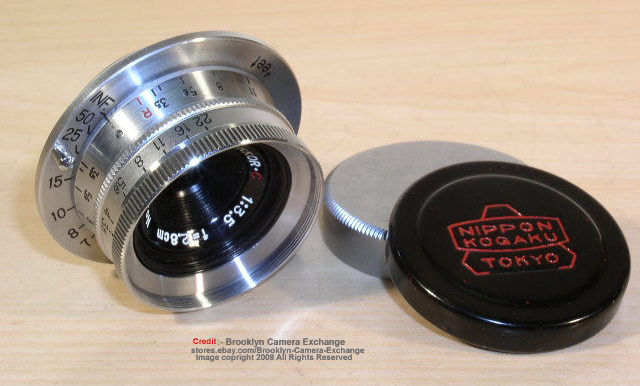 |
Credit: Image courtesy of Broklyn Camera Exchange@EBAY®. The Company also operates an active Ebay Store where he often lists
many used RARE pieces of Nikon, Leica and other oldies. Brooklyn
Camera Exchange, 1980 Broadcast Plaza, Merrick, NY 11566, Phone: 516-379-1260 / Fax
516-379-1268 e-mail: brooklyncam (AT) worldnet.att.net. Image copyright © 2006. All rights reserved.
Please respect the visual property of the contributing photographer.
|
| In fact, the
SM version of the RF W-Nikkor 2.8cm was quite scarce in numbers as compared to Nikon
bayonet-Mount version. To differentiate between the two, most noticeably is a focusing
setting knob on the SM version that couples to the distance scale ring. The minimum
focusing distance offered in the SM model is approx. 3.3 ft (approx. 1m). The filter
thread is slightly larger at 34.5mm. The minimum aperture provides a useful f/22
which is good to allow photographers with a wider range of depth of field control.
Despite being a moderate wideangle lens, it has better native characteristic in this
area (DOF). On the positive side, the lens has an excellent display of depth of field
scales marked around the index. An Infra index (R)
is available for infra-photo enthuasists. As most of the cameras in the market during
that era had no built-in frame line in the rangefinder for task such as photo composition,
I think the Optical Finder
designed specifically for the Nikon bayonet-mount version in interchangeable with
the SM version. Well, an alternate mean is using a Leica made*
or 3rd
party label Finder(s).
* Leica Model SUOOQ Folding
Type Finder also covers 28mm;
(also check the Leitz 2.8cm Summaron section for another
vesion of finder)
alternate SL00Z/12007 was introduced quite late in 1960, but most of the RF cameras
by then had offered built-in frame lines. Neither any of the early version of the
Vari-Frame/Focal Finders available during that time had provision for a 28mm wideangle
lens. |
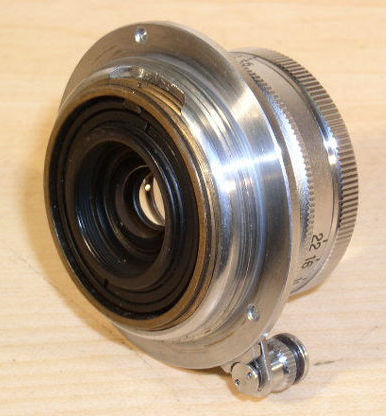 |
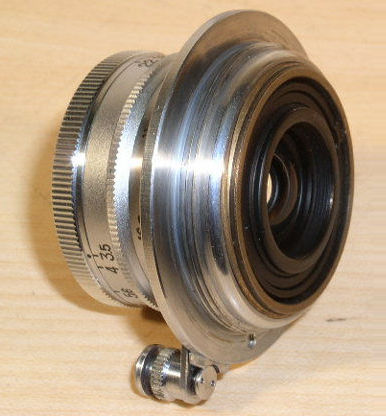 |
Credit: Images displayed herein courtesy
of Broklyn Camera Exchange
@EBAY®. The Company also operates an active Ebay Store .
Image
copyright © 2006. All rights reserved.
|

Nikon (Nippon
Kogaku K.K.) W-Nikkor.C
1:3.5 f=2.8cm
(28mm f/3.5) Bayonet S-Mount wideangle
lens
Introduced:
June, 1953; Discontinued: probably around 1964/5#
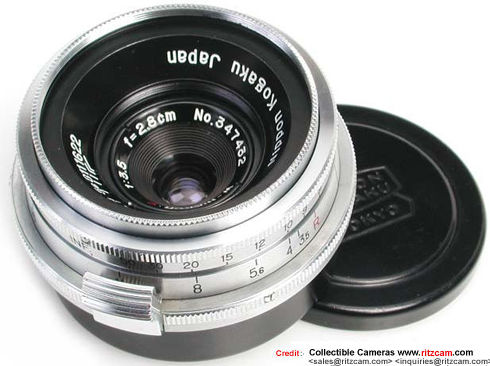 |
As mentioned
earlier, the RF W.Nikkor 1:3.5 f=2.8cm ultrawide was among the fastest wideangle
available for the rangefinder market during that time. It was also Nikon's second
wideangle lens. It has a almost similar physical appearance such as the W.Nikkor
2.5cm f/4.0 (In fact, shares the same as well as with series of f/2.5 and f/3.5 at
the 35mm focal length) but it is less troublesome and confusing to set and use the
lens during shooting as compared to the 2.5cm RF Nikkor. In the recessed front section
around the exposed front lens element, you will find the imprinted aperture scales/lens
data . Somehow, the SM version is more friendly with its the design where the aperture
scales are located on top of the lens barrel/ring, it is very much like a modern
manual focus Nikkor design. Within the bayonet mount versions, the early series produced
has a chrome on brass outfit. And among the chrome/brass series, there are two models
- one with a wider diaphragm scales and another with a narrower scales (printed above,
near the exposed front lens element, refer to the second rows of the pictures below).
Credit: Image of the chrome
version of W-Nikkor.C 1:3.5 f=2.8cm wideangle lens courtesy of Collectible Cameras®.
The company is more well known as another popular RITZ
Camera
it has a huge inventry for many used collectible equipment of major camera labels.
Image copyright © 2008. All rights reserved. Please respect the visual property
of the contributing photographer.
|
# Nikon stated date
in their official web site. Other sources: Both Nikon RF illustrated History
/ Nikon Hand Book suggested 09.1952
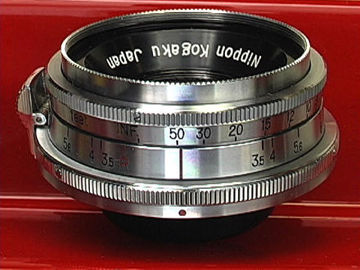 |
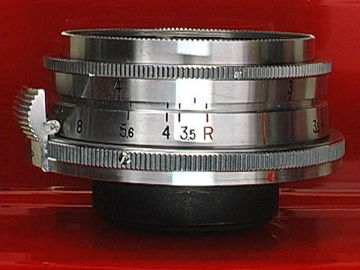 |
Early chrome
on brass Series.
Credit: Image at the left courtesy of
Mr. Kelvin from his popular gokelvincameras
@ Ebay Store
. Image Copyright © 2003. All rights reserved.
|
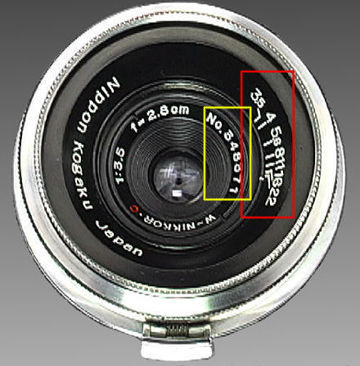 |
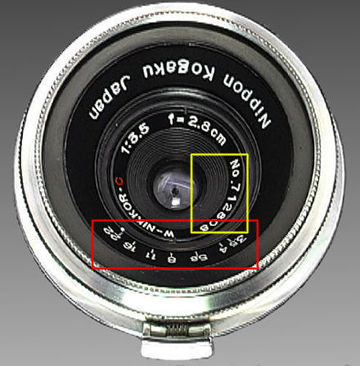 |
Notice the
difference in extended width/length of the printed / lined Depth of Field (DOF) Scales
and the serial numbers?
Credit: Image at the left courtesy of
Mr. Kelvin Li from his popular gokelvincameras
@ Ebay Store
which retails for many hard-to-find Nikon, canon, Contax oldies. Image Copyright
© 2003. All rights reserved.
|
| The late version
that has a higher serial number with widen depth of field scales printed possibly
can be regarded as slight improvement over earlier model which was a little harder
to read decreasing scales sandwitched together. There were no indications from any
source in relation to the change which involved other optical changes within the
optical structure between the two. The chrome version is a high quality lens with
very well made materials. Compact and highly portable, it feels solid in the hand
and when mounted onto a Nikon, it is just protruding slightly outward from the camera
body. As compare to the previously featured 2.5cm Nikkor, lens handling has greatly
improved with relevant lens feature properly located and easily adjustable. |
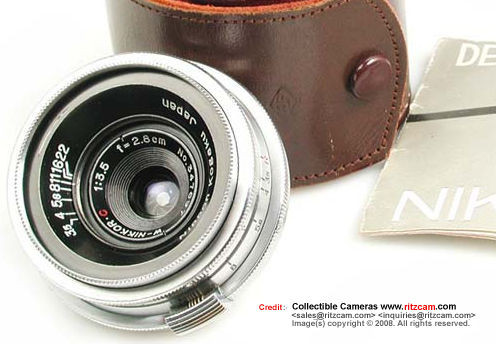 |
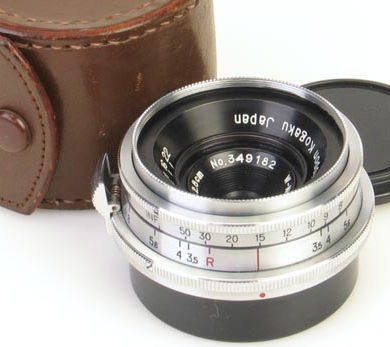 |
| Credit: Image(s) courtesy
of Collectible Cameras®. The company is more well known as another popular
RITZ Camera it has a huge inventry
for many used collectible equipment of major camera labels. Image copyright ©
2008. All rights reserved. Please respect the visual property of the contributing
photographer. |
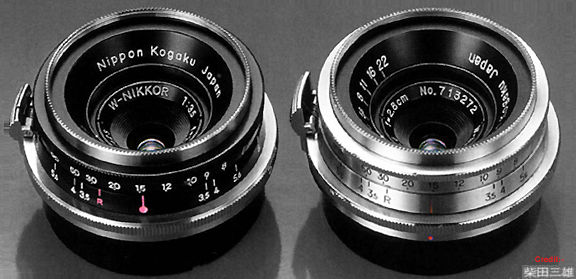 |
The black version
of the W-Nikkor 2.8cm f/3.5 also was released after 1956 (S/N 71400+ onwards. The
pictures shown below came with a dedicated metal lens hood for the 2.8cm lens as
well. Except for the focusing and stationery DOF scales on the barrel, the black
version has a lighter weight in comparison to the chrome version. However, the lens
mounting ring and main lens tube was still a solid and rigid bright chrome type.
NOTE: Black version was released in July, 1956. Barrel was changed from chrom/brass
to lighter black alloy metal type.
|
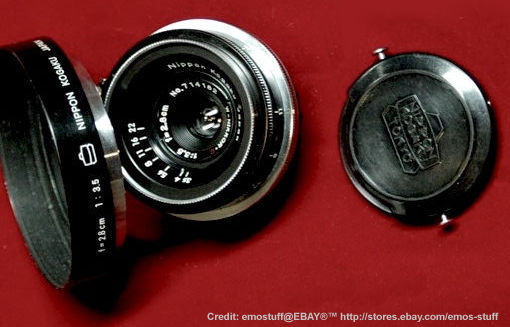 |
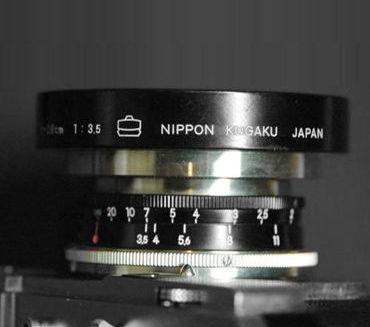 |
| Credit: Images of the black
version of W-Nikkor.C 1:3.5 f=2.8cm wideangle lens courtesy of Mr. J Emmerson from emostuff@EBAY®. Alessio also operates
an active EBAY STORE where he often
lists many used collectible equipment of major camera labels. Image copyright ©
2008. All rights reserved.
Please
respect the visual property of the contributing photographer. |
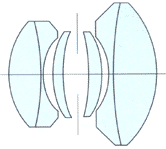 |
The RF W-Nikkor
2.8cm wideangle lens was officially launched in 1952 - that was approx. a year after
the 24mm x 34mm format's Nikon S was released. The main issue
was not the odd film format on the camera but rather the inconvenience for in-finder
photo composition because even after the Nikon S2 was launched 2 years later
in 1954 (where the model
was the first RF Nikon that truly conform to 24
x 36mm standard film format), none of the prevailing Nikon RF bodies were equipped
with a built-in frame line inside the rangefinder.
*
Optical
design for the RF W-Nikkor.C 2.8cm f/3.5 wideangle lens for Nikon rangefinder cameras.
Unless there are new information which was not known previously, it is acceptable
to conclude the optical train used can be applied to all available variations.
|
| Which means to
say, the lens requires a separate Optical Finder to aid photo composition. Well,
it was not until 5 years later that the pro-calibre Nikon SP (1957) that eventually a RF
Nikon finally was designed with a built in bright-line frame for in-finder focusing
/ photo composition which eliminating the need to hook an external finder for such
purpose. Similarly, even the SM version of the RF 2.8cm f/3.5 was having the problem
on Leica where you need assistance from a separate Optical Finder. Just as the 2.5cm
and 2.1cm RF wideangle counterparts, Nikon had also produced a dedicated finder accessory
for the lens prior to release of the Nikon SP in 1956 (scroll down below for some
pictures of the Nikon made 2.8cm Finder). As for the SM models you should refer to
the suggested matching finder(s) mentioned earlier in this site or simply CLICK
HERE
for two lovely photos of the Leica version Folding Finders (I am not sure the Carl
Zeiss Jena version of the Turret 440 Finder will fit the SM version as it has a provision
for 2.8cm focal length). Please Also take Note: Similar to Nikon SP with built-in
28mm bright-line frame inside the viewfinder, from Leica M4P onwards, the 28mm bright
frameline was built-in. |
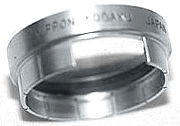 |
Here is a rare Nikon rangefinder
chrome 2.8cm zoom attachment for the variofocal viewfinder. This is a slip-on attachment which
allows the variofocal zoom finder to be used with a 28mm lens. Hard to find as they
were frequently mis-identified in the used equipment market. Credit: Image(s) displayed
here are courtesy of CamRon8888@Ebay® where his EBAY
STORE
often list many hardto find used photographic equipment.
|
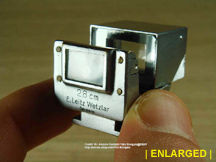 |
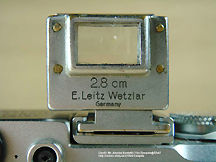 |
Two lovely photos
on a folding-type Leica SUOOQ Optical Finder. *
Also check: Zeiss
Jena 440 Turret which
has a 2.8cm provision.
You may also compre the Carl Zeiss finder types. Here is the Canon brightline frame type
Credit: Image courtesy of
Mr. Alessio Nardelli
from VINI ENOGAOA@EBAY®. He also operates an active EBAY STORE where he often
lists many used RARE pieces of Nikon, Leica and other oldies. Image copyright ©
2008. All rights reserved. Please respect the visual property of the contributing
photographer.
|
| Naturally, use
of a separate optical finder was via depth of field /distance estimation method (This
lens is almost similar to the 2.1cm where accurate focusing is not essential at normal
shooting distances as long as it is within DOF range. So, use depth of field scale
cleverly should yield adequate range of sharp focus zone for photography). Well,
as none of the original older series of RF Nikon camera models provide TTL metering
and thus, user may has to make use incident light meter or ... old sunny 16 rules
for estimating metering. Nikon did produced an own labeled exposure meter. However
not all RF Nikon can use that SP-dedicated Exposure Meter as it was only being introduced
to serve the Nikon SP mainly due to the fact that the 1957 pro-calibre Nikon SP was the first RF Nikon
body among the RF S-series that followed which offered a non rotating shutter speed
dial**
hence
enables the exposure meter be coupled onto the camera. ** Note: Amog others, the first non-rotating
shutter dial RF Canon was the Canon VI-L in 1958. |
Other
views of the RF Nikkor wideangle lens:-
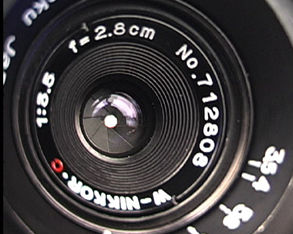 |
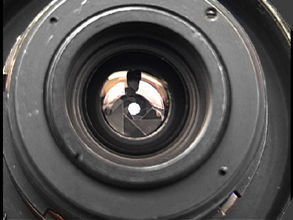 |
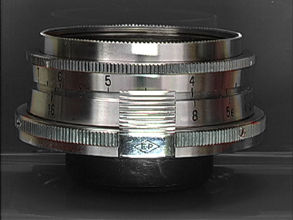 |
|
The
recessed front exposed lens element
|
Rear
section with a larger sized lens element
|
An
interesting marked "EP"* on the early all-chrome
version.
|
| Credit: All images (lens
hood, Optical Finder and rear/side views above) herein courtesy of Mr. Kelvin
from his popular gokelvincameras@Ebay Store which retails for
many hard-to-find Nikon, canon, Contax oldies. All images Copyright © 2008.
All rights reserved. |
* NOTE:- An "EP" marked item was just to differentiate
mechandize / goods that sold during the post war Japan era. EP engraved items were
distributed via military "duty-free" outlets or sometimes referred as PX
distribution system during the period. Technically, you can refer them as the same
with "MIOJ" (Made in Occupied Japan) products.
 |
A note using
the 2.8cm with the Nikon SP: The Nikon SP was the first rangefinder Nikon that
has been designed with a built-in bright-line frame for 28mm which eliminates the
use of external optical finder. The left hand section of the eyepiece is the viewfinder
for the 28mm and 35mm lenses in a SP. The full frame indicates the viewing field
for the 28mm wideangle lens; the inner frame with a solid black frame is meant for
the 35mm RF lenses. The dotted indicative line inside the smaller 35mm frame is the
parallax compensation for the 35mm when using for viewing when the subject in closer
than 4 feet. No parallax compensation is required for the wider 28mm as the wider
angle of coverage. For indicative bright-lines frame for other focal lengths when
mounted on a Nikon SP
| CLICK
HERE
| for
more info.
|
| Just like any
prime 28mm wideangle lenses, RF W-Nikkor 1:3.5 f=2.8cm has a very useful and practical
aspect for photography. Although in general, reflex photography provides a more responsive,
as well as sheer convenience in focusing accuracy and direct TTL system in comparison
to rangefinder system, but most rangefinder system lovers would prefer the old ways
in an all quiet operating/shooting sequence on the field. As compare to the likes
of the 2.1cm and 2.5cm which could easily raise the blood flow for any Nikon collectors,
this RF Nikkor 2.8cm lens may not shine in its exotic, scarce existence as collectible
but had truly served its purpose as a high quality Nikkor rangefinder imaging tool
during its entire life cycle for rangefinder photography. So, I guess rather than
solely valued it from the narrow perspective of antique camera/lens collecting, this
lens also had its native objective as a photographic lens for your RF Nikon. Along
with the emerging popularity of the reflex photographt after the Nikon F was introduced,
this rangefinder wideangle Nikkor wideangle lens has been slowly diminishing from
active limelight. Here in this site, we are just dedicating another page here in
MIR to chronicle another old Nikkor classic wideangle. Enjoy. |
 |
| Credit: Image(s) courtesy of Mr. Peter Coeln from LEICA Shop®, Austria who also operates a popular Westlicht Auction House. Image Copyright © 2008. All rights
reserved. Please respect the visual property of the contributing photographer. |

Basic
Specification for Nikon (Nippon
Kogaku K.K.) RF W-Nikkor-C 1:3.5 f=2.8cm (28mm f/3.5) rangefinder wideangle lens:-
Lens Mount:
Nikon S-mount for RF Nikon or M39 Screw Mount
Focal Length: 28mm (2.8cm); Picture Angle: 74° (45° x 64° ); Maximum
/ Minimum Aperture: f/3.5 ~ f/22
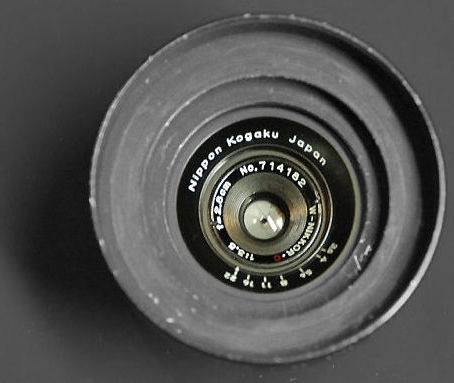 |
Optical Construction: 6 elements in 4 groups; Orthometar-Type
Minimum Focusing Distance: 90cm (approx. 3 ft) ~OO
Filter Attachment Size: Series VII (43mm) screw-in Type;
Lens Hood: 43mm Screw-in Type; Diaphragm: Manual
Dimension:-
55.8 mm dia. x 32.4 mm
long (overall)
Weight (body only): approx. 145g for Chrome version; 100g (Black); Screw Mount
(Leica Thread):- No info
Standard Accessories:
Optical Finder (2.8cm model); special rear lens cap. Screw-in type lens cap; Optional:
Lens hood 43mm, optical filters Series VII for S-Mount; Series VI for Leica SM etc.
Other Information:
Single coated only. Early Leica thread M39 Screw mount version in chrome
finish only or S-Mount for Nikon RF models. Special combined 43mm lens hood/filter
adapter or 43mm direct snap on/screw in type. Serial Numbering used:- Chrome/Brass
S-Mount starts from 346000 ~ 349000. Higher series S/N from 71200~714000. No info
on the Lighter weight black version but the model used here in this site has 714xxxx.
Total Units (Combined):- Approx. 10,000 Units. Ref: Robert Rotoloni's
An
Illustrated History on Nikon Rangefinder camera.
|
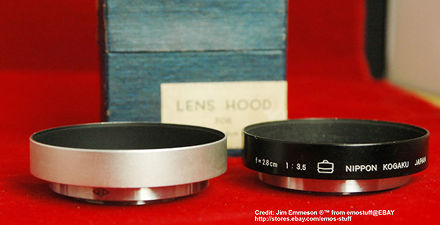 |
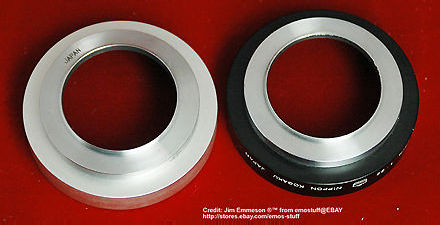 |
| In relation to
the lens hood for the 2.8cm f/3.5 RF Nikkor wideangle lens:- "... the chrome lens
hood came with the blue box, the black hood has no box, but it would be the yellow
one if it had one....". -Jim- Credit: Images of the black version
of W-Nikkor.C 1:3.5 f=2.8cm wideangle lens courtesy of Mr. J Emmerson from emostuff@EBAY®. Alessio also operates an active
EBAY STORE where he often lists many used collectible
equipment of major camera labels. Image copyright © 2008. All rights reserved. Please respect the visual property
of the contributing photographer. |

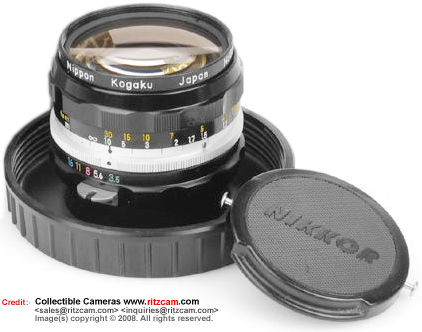 |
RELATIVE:- HHow the original
RF Nikkor lens evolved itself within the Nikkor 28mm lens group after the Reflex Nikon F was officially
announced in 1959:-
Nikon's first 28mm in the F-mount was introduced in 1960. The Nikkor-H 1:3.5 f=28mm was an non Ai lens
and it had gone through some changes until the Nikkor-H.C 1:3.5 f=28mm was introduced.
The first
Nikkor 28mm f/3.5 with a modern feel was released in 1975 as a pre-Ai version where
the Ai version was introduced in 1977. It followed with an Ai-S version in 1981. In between, the MF
Nikkor 28mm f/2.8 with a faster lens speed was introduced in 1974/5 as a Pre-Ai spec
Nikkor wideangle lens. The same lens was converted as Ai in 1977 too. The 1981
revised version
had an all new optical composition. Many believe it was one of the best spec Nikkor
wideangle.The first autofocus version AF Nikkor 28mm f/2.8S was launched in 1986
- also had a revised optical design. The AF-D version again had gone through
another round of redesigned optically in 1994 which stays as the current version
(as at 2008). Another manual focus with a very fast lens speed was the Nikkor 28mm
f/2.0 which was introduced in 1971 which followed by a Nikkor-N 28mm type in 1976.
The Ai
version was realized in 1977
along with an all Nikkor lens updating program. The last of the Nikkor 28mm f/2.0S (Ai-S) was released
in 1981. It was the last of the batch and there was never a f/2.0 being revised in
an autofocus outfit. Instead Nikon has chosen a moderate lens speed f/2.8. However,
Nikon had surprised many by introducing a ultra fast f/1.4 maximum aperture for the
autofocus Nikon in 1993. The AF Nikkor 28mm f/1.4D was delivered with
a native AF-D spec. Nikon had eventually announced its discontinuation of this superlative
autofocus wideangle lens in 2006 and concentrate on development of autofocus range
of wideangle
zoom lenses.
|
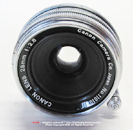 |
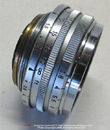 |
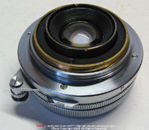 |
SUPPLEMENTARY
INFO:- It is also interesting
to note that Canon also had quickly react to Nikon's release with an even faster
lens speed original Serenar 28mm f/3.5 lens in 1952/3.
The shown version at the left was changed as Canon. In fact, overall Canon seemingly
had the larger varieties in terms of wideangles selection than Nikon. (see illustrations
CLICK
TO ENLARGED).
AlsoI would recommend you to take a look at some fabulous pictures of Canon
RF 28mm f/3.5
taken by Brian Edwards for this site as
comparison. You can compare it with another very interesting Leica thread French
Angenieux 28mm f/3.5 in retrofocus design.
|
| Credit: All images of
the Canon lens herein courtesy of Mr. kalogiros.ioannis where
I spotted these lovely photos from his website http://photocam.ibelgique.com. All images Copyright
© 2008. All rights reserved. |
|
Comparison
among:-
Leica/Leitz Summaron
1:3.5 f=28mm
Canon Serenar
2.8cm lenses
Contax Carl Zeiss Jena Tessar 1:8 f=2.8cm (various)
|
W-Nikkor-O 1:4 f=2.1cm | W-Nikkor.C 1:4 f=2.5cm | W-Nikkor.C
1:3.5 f= 2.8cm | W-Nikkor.C 3.5cm lens Group (3.5/2.5/1.8) | Stereo-Nikkor 1:3.5 f=3.5cm | 5cm (50mm) lens group | RF Micro-Nikkor
1:3.5 f=5cm | Nikkor-P.C
1:2 f=8.5cm lens group / Nikkor-S.C 1:1.5 f=8.5cm lens group | Nikkor-P.C
1:2.5 f=10.5cm lens group
/ Nikkor-T 1:4 f=10.5cm | Nikkor-Q.C 13.5cm lens group: 135/4, 135/3.5 Early
/ Last Version, 135/4 Bellow lens
| Nikkor-H 1:2.5
f=18cm | Nikkor-Q 1:4 f=25cm
| Nikkor-T 1:4.5 f=35cm | Nikkor-T.C 1:5 f=50cm | Reflex-Nikkor 100cm f/6.3
System Accessories
for Nikon Rangefinder cameras
Optical Finders (4 parts):- Fixed Focal length Finders (index page): 2.1cm,
2.5cm, 2.8cm, 3.5cm,
35cm Stereo,
5cm, 8.5cm, 10.5cm,
13.5cm | Variframe / Varifocal / Sport-frames
| Nikon Reflex Housing
Nikon
S36/S72/S250 Motor Drives
/ S36 Manual |
light meters | Nikon RF Flash/Speedlights | Close-up
photography / Repro Copy Outfit / Nikon Bellow Focusing Device (in progress) | Cases/Compartments | Lens & body caps,
Lens Hoods/shades,
Original Price Lists |
packaging/boxes
Instruction
Manuals
Related info:- Main index page
for Leica/Leitz | Contax/Carl Zeiss | Seiki Kogaku (Canon)
| Message Board | lenses | Message Board | RF cameras
|

Back to - Nikon RF-Nikkor lenses
(Rangefinder):- Main Index Page
Nikon
Auto
Focus
Nikkor lenses:- Main Index Page
Nikon Manual
Focus
Nikkor lenses:- Main Index Page
| Back | Main Index Page of Pictorial
History of Nikon SLRs
about this photographic
web site
 |
Home - Photography in Malaysia
|

Credit:- Special thanks to all the contributors of images
and content which made up the basis of the site. Note:certain content and
images appeared in this site were either scanned from official marketing leaflets,
brochures, sales manuals or publications published by Nikon over the years and/or
contribution from surfers who claimed originality of their work for educational purposes.
The creator of the site will not be responsible for may discrepancies arise from
such dispute except rectifying them after verification."Nikon",
"Nikkormat", "Nippon Kokagu KK" & "Nikkor"
are registered trade name of Nikon Corporation Inc., Japan. Site made with an Apple
G5 IMac.
|